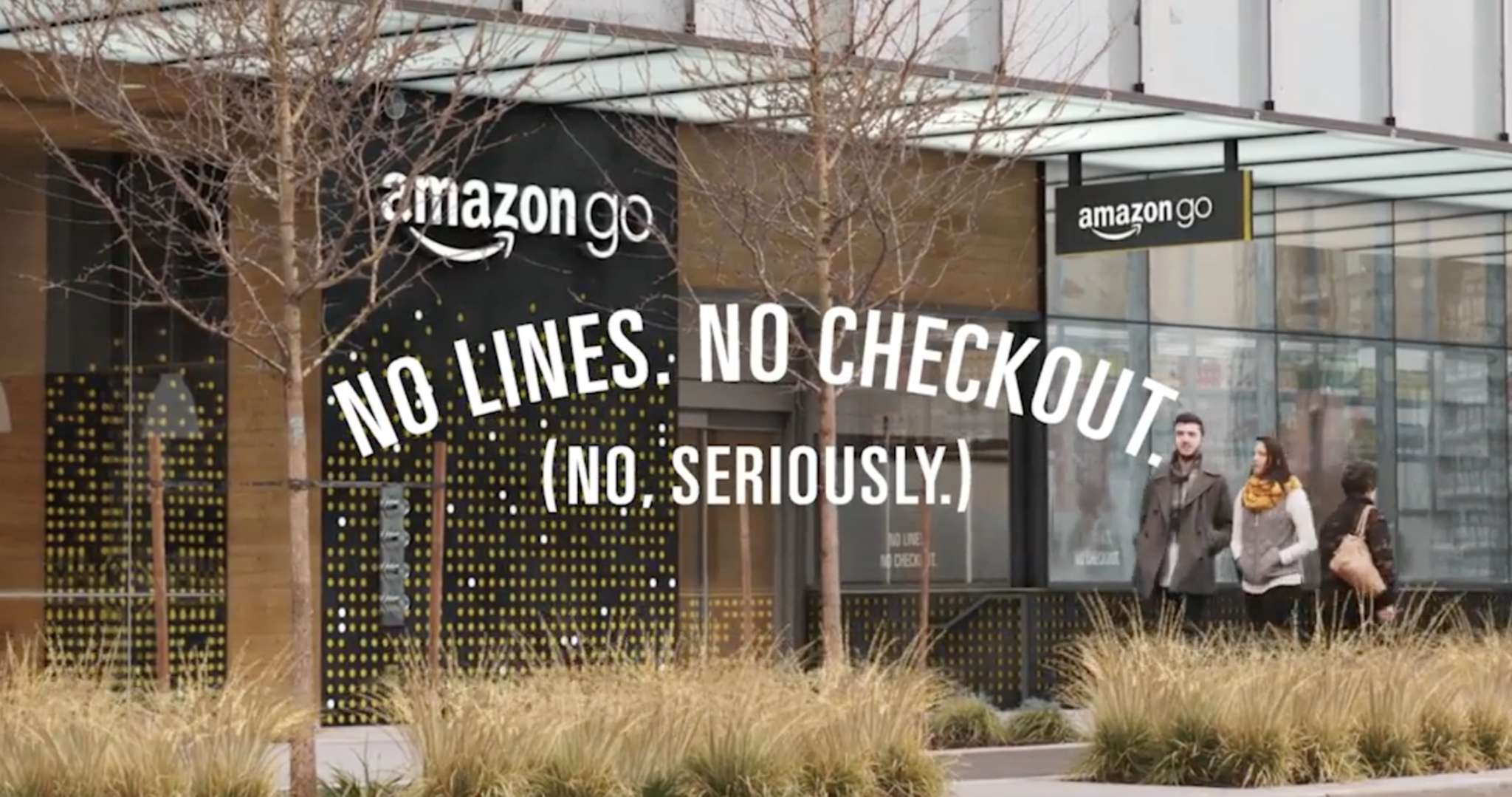 Amazon Go[/caption] Amazon has created a new-look convenience store that lets you buy goods without ever going through a checkout. Dubbed ‘Go,’ the store is almost entirely automated. What does that mean for humans, and jobs? Here’s how it works: the Amazon Go app has a QR code you must scan at subway-style turnstiles to get into the store. Once you’re inside, Amazon uses machine learning, computer vision and artificial intelligence (via sensors) to ‘watch’ what you’re purchasing. After you’ve grabbed all the things you need, you simply walk out. Amazon’s tagline for Go is “no lines, no checkouts, no registers.” That’s insinuating you’ll be able to avoid interaction with people, too. It’s worth noting that the space (in downtown Seattle, and currently only open to Amazon employees involved in a beta program) is roughly 1,800 square feet, so it’s not as if Amazon re-created a proper grocery store. But it has prepared meals, ready-to-eat items created by on-site chefs, various sundry and pantry items as well as Blue Apron-esque meal kits for two. Still in beta, Amazon is planning to open Go up to the public early next year. It all sounds sublime, but there’s a lot we don’t know. Is Amazon Go part of Prime? Are there expansion plans to other cities (we’d have to assume so, but who knows)? More critically, who is running the store day-to-day?
Amazon Go[/caption] Amazon has created a new-look convenience store that lets you buy goods without ever going through a checkout. Dubbed ‘Go,’ the store is almost entirely automated. What does that mean for humans, and jobs? Here’s how it works: the Amazon Go app has a QR code you must scan at subway-style turnstiles to get into the store. Once you’re inside, Amazon uses machine learning, computer vision and artificial intelligence (via sensors) to ‘watch’ what you’re purchasing. After you’ve grabbed all the things you need, you simply walk out. Amazon’s tagline for Go is “no lines, no checkouts, no registers.” That’s insinuating you’ll be able to avoid interaction with people, too. It’s worth noting that the space (in downtown Seattle, and currently only open to Amazon employees involved in a beta program) is roughly 1,800 square feet, so it’s not as if Amazon re-created a proper grocery store. But it has prepared meals, ready-to-eat items created by on-site chefs, various sundry and pantry items as well as Blue Apron-esque meal kits for two. Still in beta, Amazon is planning to open Go up to the public early next year. It all sounds sublime, but there’s a lot we don’t know. Is Amazon Go part of Prime? Are there expansion plans to other cities (we’d have to assume so, but who knows)? More critically, who is running the store day-to-day?
Will Amazon Go Take Jobs Away From Humans?
[caption id="attachment_138642" align="aligncenter" width="2178"]  Amazon Go[/caption] Amazon has created a new-look convenience store that lets you buy goods without ever going through a checkout. Dubbed ‘Go,’ the store is almost entirely automated. What does that mean for humans, and jobs? Here’s how it works: the Amazon Go app has a QR code you must scan at subway-style turnstiles to get into the store. Once you’re inside, Amazon uses machine learning, computer vision and artificial intelligence (via sensors) to ‘watch’ what you’re purchasing. After you’ve grabbed all the things you need, you simply walk out. Amazon’s tagline for Go is “no lines, no checkouts, no registers.” That’s insinuating you’ll be able to avoid interaction with people, too. It’s worth noting that the space (in downtown Seattle, and currently only open to Amazon employees involved in a beta program) is roughly 1,800 square feet, so it’s not as if Amazon re-created a proper grocery store. But it has prepared meals, ready-to-eat items created by on-site chefs, various sundry and pantry items as well as Blue Apron-esque meal kits for two. Still in beta, Amazon is planning to open Go up to the public early next year. It all sounds sublime, but there’s a lot we don’t know. Is Amazon Go part of Prime? Are there expansion plans to other cities (we’d have to assume so, but who knows)? More critically, who is running the store day-to-day?
Amazon Go[/caption] Amazon has created a new-look convenience store that lets you buy goods without ever going through a checkout. Dubbed ‘Go,’ the store is almost entirely automated. What does that mean for humans, and jobs? Here’s how it works: the Amazon Go app has a QR code you must scan at subway-style turnstiles to get into the store. Once you’re inside, Amazon uses machine learning, computer vision and artificial intelligence (via sensors) to ‘watch’ what you’re purchasing. After you’ve grabbed all the things you need, you simply walk out. Amazon’s tagline for Go is “no lines, no checkouts, no registers.” That’s insinuating you’ll be able to avoid interaction with people, too. It’s worth noting that the space (in downtown Seattle, and currently only open to Amazon employees involved in a beta program) is roughly 1,800 square feet, so it’s not as if Amazon re-created a proper grocery store. But it has prepared meals, ready-to-eat items created by on-site chefs, various sundry and pantry items as well as Blue Apron-esque meal kits for two. Still in beta, Amazon is planning to open Go up to the public early next year. It all sounds sublime, but there’s a lot we don’t know. Is Amazon Go part of Prime? Are there expansion plans to other cities (we’d have to assume so, but who knows)? More critically, who is running the store day-to-day?
 Amazon Go[/caption] Amazon has created a new-look convenience store that lets you buy goods without ever going through a checkout. Dubbed ‘Go,’ the store is almost entirely automated. What does that mean for humans, and jobs? Here’s how it works: the Amazon Go app has a QR code you must scan at subway-style turnstiles to get into the store. Once you’re inside, Amazon uses machine learning, computer vision and artificial intelligence (via sensors) to ‘watch’ what you’re purchasing. After you’ve grabbed all the things you need, you simply walk out. Amazon’s tagline for Go is “no lines, no checkouts, no registers.” That’s insinuating you’ll be able to avoid interaction with people, too. It’s worth noting that the space (in downtown Seattle, and currently only open to Amazon employees involved in a beta program) is roughly 1,800 square feet, so it’s not as if Amazon re-created a proper grocery store. But it has prepared meals, ready-to-eat items created by on-site chefs, various sundry and pantry items as well as Blue Apron-esque meal kits for two. Still in beta, Amazon is planning to open Go up to the public early next year. It all sounds sublime, but there’s a lot we don’t know. Is Amazon Go part of Prime? Are there expansion plans to other cities (we’d have to assume so, but who knows)? More critically, who is running the store day-to-day?
Amazon Go[/caption] Amazon has created a new-look convenience store that lets you buy goods without ever going through a checkout. Dubbed ‘Go,’ the store is almost entirely automated. What does that mean for humans, and jobs? Here’s how it works: the Amazon Go app has a QR code you must scan at subway-style turnstiles to get into the store. Once you’re inside, Amazon uses machine learning, computer vision and artificial intelligence (via sensors) to ‘watch’ what you’re purchasing. After you’ve grabbed all the things you need, you simply walk out. Amazon’s tagline for Go is “no lines, no checkouts, no registers.” That’s insinuating you’ll be able to avoid interaction with people, too. It’s worth noting that the space (in downtown Seattle, and currently only open to Amazon employees involved in a beta program) is roughly 1,800 square feet, so it’s not as if Amazon re-created a proper grocery store. But it has prepared meals, ready-to-eat items created by on-site chefs, various sundry and pantry items as well as Blue Apron-esque meal kits for two. Still in beta, Amazon is planning to open Go up to the public early next year. It all sounds sublime, but there’s a lot we don’t know. Is Amazon Go part of Prime? Are there expansion plans to other cities (we’d have to assume so, but who knows)? More critically, who is running the store day-to-day?


